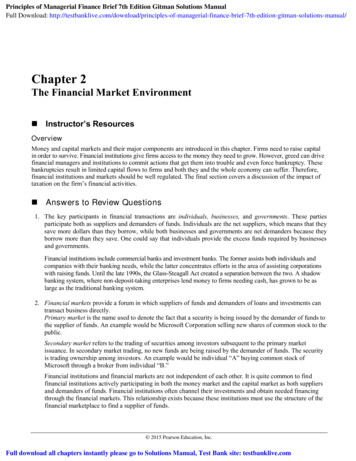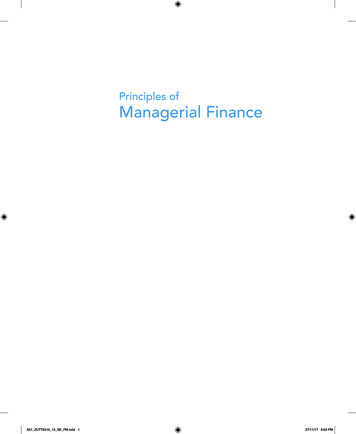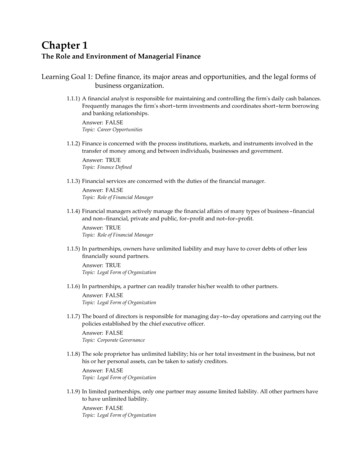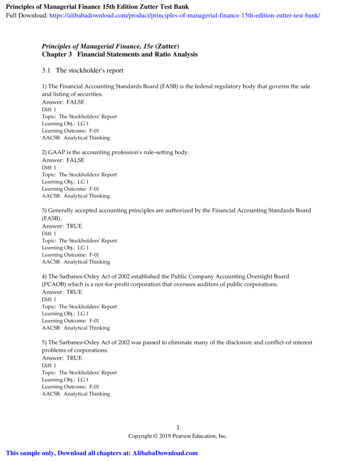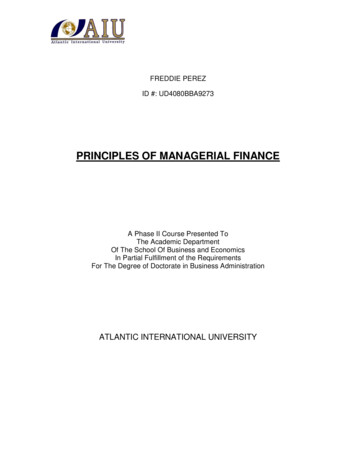
Transcription
FREDDIE PEREZID #: UD4080BBA9273PRINCIPLES OF MANAGERIAL FINANCEA Phase II Course Presented ToThe Academic DepartmentOf The School Of Business and EconomicsIn Partial Fulfillment of the RequirementsFor The Degree of Doctorate in Business AdministrationATLANTIC INTERNATIONAL UNIVERSITY
TABLE OF CONTENTS1. Introduction2. Basic Concepts in Principles of Managerial Financea.Managerial Financeb.Financial Statements and Analysisc.Cash Flow and Financial Planningd.Time Value of Moneye.Risk and Returnf.Interest Rates and Bond Valuationg.Stock Valuationh.Capital Budgeting Cash Flowsi.The Cost of Capitalj.Leverage and Capital Structurek.Dividend Policyl.Working Capital and Current Assets Managementm.Current Liabilities Management3. General Analysis4. General Recommendations5. Conclusions6. References
1. INTRODUCTIONManagerial Finance is essentially a combination of economy and accounting. First,finance managers utilized accounting information, cash flows, etc., for planning anddistribution of finance resources of the company. Secondly, managers useeconomic principles as a guide for financial decision making that favor the interestof the organization. In other words, finance constitutes an area applied ineconomics that is supported by accounting information.Since finance reflexes what adds value to a company, finance managers constituteimportant individuals for the majority of business.Financial managers measure the development of the company, they determine thefinancial consequences, the tendencies and recommend on how to use the assetsof the organization for the well being and survival of the business in the long run. Atthe same time financial managers seek for the best external financial institutionsand recommend the best combination of financial resources for the shareholders ofthe company / organization.In today s world it is imperative to have the means and tools needed to becompetitive; there must be a vision that there are no borders in order to make abusiness successful and to guarantee its survival in the long run. Decision makingbased on different scenarios must be done in order to assure the right use of theassets on the company.In the following document we will present the concepts in Principles of ManagerialFinance and will present the basics to understand in order to make the bestdecision for a business / company.
2. BASIC CONCEPTS IN PRINCIPLES OF MANAGERIALFINANCEa. Managerial FinanceAccording to Gitman, Lawrence (2003), “Managerial finance is the branch offinance that concerns itself with the managerial significance of financetechniques. It is focused on assessment rather than technique”.The difference between a managerial and a technical approach can be seenin the questions one might ask of annual reports. One concerned withtechnique would be primarily interested in measurement. They would ask:are moneys being assigned to the right categories? Was generally acceptedaccounting practice GAAP followed?One concerned with management though would want to know what the figuresmean.They might compare the returns to other businesses in their industry and ask: arewe performing better or worse than our peers? If so, what is the source of theproblem? Do we have the same profit margins? If not, why? Do we have the sameexpenses? Are we paying more for something than our peers?Managerial finance is an interdisciplinary approach that borrows from bothmanagerial accounting and corporate finance.b. Financial Statements and AnalysisFinancial statements (or financial reports) are formal records of a business'financial activities. These statements provide an overview of a business'profitability and financial condition in both short and long term. There are four basicfinancial statements:
1. Balance sheet: also referred to as statement of financial condition, reportson a company's assets, liabilities and net equity as of a given point in time.2. Income statement: also referred to as Profit or loss statement, reports on acompany's results of operations over a period of time.3. Cash flow statement: reports on a company's cash flow activities,particularly its operating, investing and financing activities.4. Statement of retained earnings: explains the changes in a company'sretained earnings over the reporting period.For large corporations, these statements are often complex and may include anextensive set of notes to the financial statements and management discussion andanalysis. The notes typically describe each item on the balance sheet, incomestatement and cash flow statement in further detail. Notes to financial statementsare considered an integral part of the financial statements.According to Gitman, Lawrence (2003), "The objective of financial statementsis to provide information about the financial strength, performance andchanges in financial position of an enterprise that is useful to a wide range ofusers in making economic decisions. Financial statements should beunderstandable,relevant,reliableand comparable.Reportedassets,liabilities and equity are directly related to an organization’s financialposition. Reported income and expenses are directly related to anorganization’s financial performance”.Financial statements are intended to be understandable by readers who have areasonable knowledge of business and economic activities and accounting andwho are willing to study the information diligently.The difference between these inflows and outflows is the net income, also shownin the income statement.Financial statements are used by a diverse group of parties, both inside andoutside a business. Generally, these users are:1. Internal Users: are owners, managers, employees and other parties who aredirectly connected with a company.
Owners and managers require financial statements to make important businessdecisions that affect its continued operations. Financial analyses are thenperformed on these statements to provide management with a more detailedunderstanding of the figures. These statements are also used as part ofmanagement's report to its stockholders, as it form part of its Annual Report.2. External Users: are potential investors, banks, government agencies and otherparties who are outside the business but need financial information about thebusiness for a diverse number of reasons.Prospective investors make use of financial statements to assess the viability ofinvesting in a business. Financial analyses are often used by investors and isprepared by professionals (financial analysts), thus providing them with the basis inmaking investment decisions.Financial institutions (banks and other lending companies) use them to decidewhether to grant a company with fresh working capital or extend debt securities(such as a long-term bank loan or debentures) to finance expansion and othersignificant expenditures.Government entities (tax authorities) need financial statements to ascertain thepropriety and accuracy of taxes and other duties declared and paid by a company.Media and the general public are also interested in financial statements for avariety of reasons.The rules for the recording, measurement and presentation of government financialstatements may be different from those required for business and even for nonprofit organizations. They may use either of two accounting methods: accrualaccounting, or cash accounting, or a combination of the two. A complete set ofchart of accounts is also used that is substantially different from the chart of aprofit-oriented business.Although the legal statutes may differ from country to country, an audit of financialstatements are usually, but not exclusively required for investment, financing, and
tax purposes. These are usually performed by independent accountants or auditingfirms. Results of the audit are summarized in an audit report that either provide anunqualified opinion on the financial statements or qualifications as to its fairnessand accuracy. The audit opinion on the financial statements is usually included inthe annual report.According to Gitman, Lawrence (2003), “Fundamental analysis of a businessinvolves analyzing its income statement, financial statements and health, itsmanagement and competitive advantages, and its competitors and markets.The analysis is performed on historical and present data, but with the goal tomake financial projections. There are several possible objectives:to calculate a company's credit risk,to make projection on its business performance,to evaluate its management and make internal business decisions,to make the company's stock valuation and predict its probable priceevolutionWhen the objective of the analysis is to determine what stock to buy and atwhat price, there are two basic methodologies.1. Fundamental analysis maintains that markets may misprice a securityin the short run but that the "correct" price will eventually be reached.Profits can be made by trading the mispriced security and thenwaiting for the market to recognize its "mistake" and reprise thesecurity.2. Technical analysis maintains that all information is reflected already inthe stock price, so fundamental analysis is a waste of time. Trends'are your friend' and sentiment changes predate and predict trendchanges. Investors' emotional responses to price movements lead torecognizable price chart patterns. Technical analysis does not carewhat the 'value' of a stock is. Their price predictions are onlyextrapolations from historical price patterns”.
Managers may use fundamental analysis to correctly value good and badcompanies. Even bad company's stock goes up and down, creating opportunitiesfor profits.Managers may use fundamental analysis to determine future growth rates forbuying high priced growth stocks.The analysis of a business' health starts with financial statement analysis thatincludes ratios. It looks at dividends paid, operating cash flow, new equity issuesand capital financing.The determined growth rates (of income and cash) and risk levels (to determinethe discount rate) are used in various valuation models. The foremost is thediscounted cash flow model, which calculates the present value of the futuredividends received by the investor, along with the eventual sale price.c. Cash Flow and Financial PlanningAccording to Brigham, Eugene and Johnson, Ramon (1980), “Cash flow is anaccounting term that refers to the amounts of cash being received and spentby a business during a defined period of time, sometimes tied to a specificproject”. Measurement of cash flow can be used to:To evaluate the state or performance of a business or project.To determine problems with liquidity. Being profitable does not necessarilymean being liquid. A company can fail because of a shortage of cash, evenwhile profitable.To generate project rate of returns. The time of cash flows into and out ofprojects are used as inputs to financial models such as internal rate ofreturn, and net present value.To examine income or growth of a business when it is believed that accrualaccounting concepts do not represent economic realities. Alternately, cash
flow can be used to 'validate' the net income generated by accrualaccounting.Cash flow as a generic term may be used differently depending on context, andcertain cash flow definitions may be adapted by analysts and users for their ownuses. Common terms (with relatively standardized definitions) include operatingcash flow and free cash flow.Cash flows can be classified into:1. Operational cash flows: Cash received or expended as a result of thecompany's core business activities.2. Investment cash flows: Cash received or expended through capitalexpenditure, investments or acquisitions.3. Financing cash flows: Cash received or expended as a result of financialactivities, such as receiving or paying loans, issuing or repurchasing stock,and paying dividends.All three together are necessary to reconcile the beginning cash balance to theending cash balance.The cash flow statement is one of the four main financial statements of a company.The cash flow statement can be examined to determine the short-termsustainability of a company. If cash is increasing (and operational cash flow ispositive), then a company will often be deemed to be healthy in the short-term.Increasing or stable cash balances suggest that a company is able to meet its cashneeds, and remain solvent. This information cannot always be seen in the incomestatement or the balance sheet of a company. For instance, a company may begenerating profit, but still have difficulty in remaining solvent.The cash flow statement breaks the sources of cash generation into three sections:operational cash flows, investing and financing. This breakdown allows the user offinancial statements to determine where the company is deriving its cash foroperations.Many investors have lost faith in the value of published income statements. Oneway to by-pass them is to use cash flows instead. The feeling is that:
Cash flows cannot be forged. This presumption may be inaccurate.Cash liquidity is necessary for survival. This is true, and even truer forbusinesses with limited access to financing.Cash is tangible proof of incomeCash flow planning is critical to financial success. It is useful to consider threeaspects of cash flow planning:1. Cash flow analysis - researching historical cash flows to understand thecurrent situation.2. Cash flow planning - considering where changes should be made to cashflows in order to accomplish prioritized goals.3. Cash flow management - having the discipline to stay with the plan.According to Brigham, Eugene and Johnson, Ramon (1980), “Financialplanning is the task of determining how a business will afford to achieve itsstrategic goals and objectives. Usually, a company creates a Financial Planimmediately after the vision and objectives have been set. The Financial Plandescribes each of the activities, resources, equipment and materials that areneeded to achieve these objectives, as well as the timeframes involved”.The Financial Planning activity involves the following tasks:Assess the business environmentConfirm the business vision and objectivesIdentify the types of resources needed to achieve these objectivesQuantify the amount of resource (labor, equipment, materials)Calculate the total cost of each type of resourceSummarize the costs to create a budgetIdentify any risks and issues with the budget setPerforming Financial Planning is critical to the success of any organization. Itprovides the Business Plan with rigor, by confirming that the objectives set are
achievable from a financial point of view. It also helps the CEO to set financialtargets for the organization, and reward staff for meeting objectives within thebudget set.d. Time Value of MoneyAccording to Brigham, Eugene and Johnson, Ramon (1980), “The time valueof money is the premise that an investor prefers to receive a payment of afixed amount of money today, rather than an equal amount in the future, allelse being equal.In other words, the present value of a certain amount of money is greaterthan the present value of the right to receive the same amount of money attime t in the future. This is because the amount could be deposited in aninterest-bearing bank account (or otherwise invested) from now to time t andyield interest. (Consequently, lenders acting at arm's length demand interestpayments for use of their financial capital. Additional motivations fordemanding interest are to compensate for the risk of borrower default andthe risk of inflation, as well as other, more technical considerations.)”All of the standard calculations are based on the most basic formula, the presentvalue of a future sum, "discounted" to a present value.Some standard calculations based on the time value of money are:Present Value (PV) of an amount that will be received in the future.Future Value (FV) of an amount invested (such as in a deposit account)now at a given rate of interest.Present Value of an Annuity (PVA) is the present value of a stream of(equally-sized) future payments, such as a mortgage.Future Value of an Annuity (FVA) is the future value of a stream ofpayments (annuity), assuming the payments are invested at a given rate ofinterest.Present Value of a Perpetuity is the value of a regular stream of paymentsthat lasts "forever", or at least indefinitely.
Formulas; According to Brigham, Eugene and Johnson, Ramon (1980),Present value of a future sumThe present value formula is the core formula for the time value of money; each ofthe other formulas is derived from this formula. For example, the annuity formula isthe sum of a series of present value calculations.The present value (PV) formula has four variables, each of which can be solvedfor:1. PV is the value at time 02. FV is the value at time n3. i is the rate at which the amount will be compounded each period4. n is the number of periodsFuture value of a present sumThe future value (FV) formula is similar and uses the same variables.Present value of an annuityThe present value of an annuity (PVA) formula has four variables, each ofwhich can be solved for:1. PVA the value of the annuity at time 02. A the value of the individual payments in each compounding period
3. r equals the interest rate that would be compounded for each period oftime4. n is the number of payment periods.Future value of an annuityThe future value of an annuity (FVA) formula has four variables, each of whichcan be solved for:1. FV(A) the value of the annuity at time n2. A the value of the individual payments in each compounding period3. r equals the interest rate that would be compounded for each period oftime4. n is the number of payment periods.Present value of a growing annuitySimilar to the formula for an annuity, the present value of a growing annuity(PVGA) uses the same variables with the addition of G as the rate of growth of theannuity (A is the annuity payment in the first period). This is a calculation that israrely provided for on financial calculators.
Present value of a perpetuityThe PV of a perpetuity (a perpetual annuity) formula is simple division.Present value of a growing perpetuityWhen the perpetual annuity payment grows at a fixed rate (g) the value istheoretically determined according to the following formula. In practice, there arefew securities with precisely these characteristics, and the application of thisvaluation approach is subject to various qualifications and modifications. Mostimportantly, it is rare to find a growing perpetual annuity with fixed rates of growthand true perpetual cash flow generation. Despite these qualifications, the generalapproach may be used in valuations of real estate, equities, and other assets.Annuity derivationThe formula for the present value of a regular stream of future payments (anannuity) is derived from a sum of the formula for future value of a single futurepayment, as below, where C is the payment amount and n the time period.A single payment C at future time i has the following future value at future time n:Summing over all payments from time 1 to time n, then reversing the order ofterms and substituting k n i:
Note that this is a geometric series, with the initial value being a C, themultiplicative factor being 1 r, with n terms. Applying the formula forgeometric series, we get the following:The present value of the annuity (PVA) is obtained by simply dividingby (1 r)n:Another simple and intuitive way to derive the future value of an annuity is toconsider an endowment, whose interest is paid as the annuity, and whose principalremains constant. The principal of this hypothetical endowment can be computedas that whose interest equals the annuity payment amount:Principal C / rNote that no money enters or leaves the combined system of endowmentprincipal accumulated annuity payments, and thus the future value ofthis system can be computed simply via the future value formula:FV P
Managerial Finance is essentially a combination of economy and accounting. First, finance managers utilized accounting information, cash flows, etc., for planning and distribution of finance resources of the company. Secondly, managers use economic principles as a guide for financial decision making that favor the interest .File Size: 445KB
